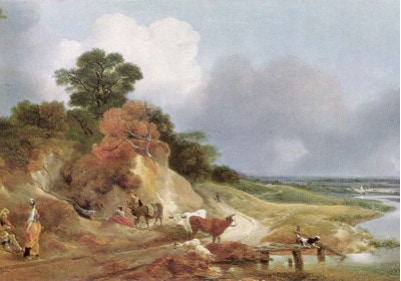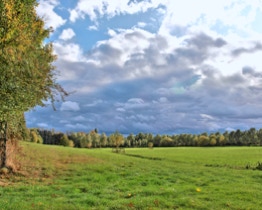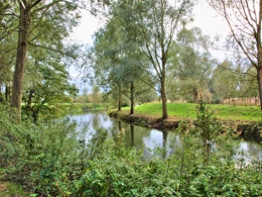

Gainsborough Country
Cultural Heritage

Gainsborough’s landscape, reproduced left has been shown by the research of local historians to be a view from a point below Great Bevels, an ancient house near Bures. Today the view is obscured by more recent tree plantings but careful examination of the painting reveals the small white church to the right in the distance, to be St Mary’s at Bures. The road, just a track in the painting still rises and curves around a rising bank and though changed, the unblighted views in this part of the valley are still quite outstandingly beautiful.
Gainsborough Country - the valley from Constable Country to Sudbury, past Bures, Lamarsh and on to Twinstead.
Thomas Gainsborough who lived from 1727 to 1788 was an English portrait and landscape painter. He was born in Sudbury, Suffolk, a town set in the Stour Valley. In 1740 he went to London and became the assistant and pupil of the French engraver Hubert Gravelot . He was also influenced in his youth by the painter Francis Hayman and studied the landscapes of the great 17th-century Dutch artists. In 1745 he returned to Sudbury, later moving to Ipswich and finally to Bath. Though he was primarily a portrait painter for the wealthy, his favourite subject was landscape, painted entirely for his own pleasure. His works were among the first great landscapes painted in England.
The Stour valley landscape can clearly be seen influencing his work though Gainsborough himself did not reference the actual locations for his paintings as directly as fellow artist John Constable. Constable who lived from 1776 to 1837 was also born in Suffolk and he, along with Turner were the leading figures in English landscape painting of the 19th century. Constable, son of a prosperous miller, showed artistic talent while very young but did not devote himself to art until he was 23, when he went to London to study at the Royal Academy. He became famous for his landscapes of Suffolk. Influenced by the 17th-century landscape painters Ruisdael and Claude Lorrain, his poetic approach to nature paralleled in spirit by that of his contemporary, the poet Wordsworth.
What is the relevance of these artists to the power line issue?
In Constable Country, further along the valley in the Dedham Vale, power lines crossed the main footpath between Flatford and Dedham, ran over the River Stour at Fen Bridge, and impacted on views of Dedham Church. “This has been one of the most satisfying results of our lobbying work,” said Katherine Blake, Dedham Vale AONB and Stour Valley Project Manager. “This landscape has been an inspiration to artists and writers for centuries, and the Project works closely with landowners, land managers and environmental organisations to conserve and enhance the natural beauty of the area." Nigel Collier, EDF Energy Networks Protected Areas Officer, added: “The projects to remove power lines from the Dedham Vale AONB will have a tremendous positive impact on the views of this beautiful area of countryside.” Approximately two miles of overhead power lines and over 30 wooden poles are being removed from the AONB between Dedham and East Bergholt, as part of a £450,000 scheme managed by EDF Energy Networks. Ofgem, the industry regulator, has made £2.9 million available to invest in projects to remove power lines in AONBs and National Parks in the East of England up until 2010
Stour Valley Underground believe that the value judgement and strategy applied in Constable Country should now be applied in Gainsborough Country such that the inspirational landscape of the entire Stour Valley is returned to a natural vista that will surely inspire future generations.

Typical low relief landscape in “Gainsborough Country”

The riverside landscape in Gainsborough’s painting, as it is today

The road, formerly the track in Gainsborough’s painting

The meandering River Stour at the point depicted in Gainsborough’s painting

St Mary’s Church in Great Henny features in Gainsborough’s work “Cornard Wood”

Thomas Gainsborough’s painting, “Cornard Wood” (shown left), when seen in the National Gallery again features a church in the distance and here it is the highly individual spire of St. Mary’s in Great Henny, (shown above) that allows us to identify the inspiration behind Gainsborough’s landscape.
Great Henny, like Cornard, is in the Stour Valley.
